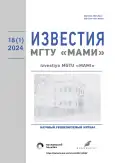Analysis of computer-aided manufacturing systems
- Authors: Gusev S.S.1, Makarov V.V.2
-
Affiliations:
- Rostelecom
- V.A. Trapeznikov Institute of Control Science of the RAS
- Issue: Vol 18, No 1 (2024)
- Pages: 63-74
- Section: Electrotechnical facilities and systems
- URL: https://journals.rcsi.science/2074-0530/article/view/256847
- DOI: https://doi.org/10.17816/2074-0530-624783
- ID: 256847
Cite item
Full Text
Abstract
BACKGROUND: Process of design and development of a controlling program starts after the conclusion of the previous stage of the product life cycle and it begins with the work of an engineering center. At this stage, development of new design solutions takes place and technical requirements specification for the developed product is approved with the customer.
AIM: Process of design and development of a controlling program starting after the conclusion of the previous stage of the product life cycle and beginning with the work of an engineering center.
METHODS: Based on that, the drawing of the product including technical requirements is prepared. Then, generally, this drawing is handed over to the department of process engineers-programmers where the design and development of the process control for the product takes place. As a rule of thumb, at this stage, a process engineer seeks advice from a drawing developer to obtain a full information about the product in order to eliminate any mistakes. There are possible cases where at this moment the drawing is given back to the engineering department due to impossibility of product manufacturing caused by lack of manufacturing abilities or poor design solutions making describing of manufacturing technology impossible.
RESULTS: The study result is the fact that the next stage that follows obtaining the technical requirements specification is development of technological process. The technological process should be formulated properly in terms of technology in accordance with internal enterprise standards (each enterprise can have own standards but the formulation structure is unite) and be sufficiently informative for the sake of exclusion of high chances of rejects during manufacturing. As the statistics shows, many enterprises suffer from high reject rate caused by improper behavior of CNC operators because of disappointments to the technological process.
CONCLUSIONS: Based on results of metalworking simulation, the method aimed to optimization of the strategy of machining high-speed metalworking at development of a controlling program has been formulated.
Full Text
##article.viewOnOriginalSite##About the authors
Sergey S. Gusev
Rostelecom
Author for correspondence.
Email: gs-serg@mail.ru
ORCID iD: 0000-0002-6070-9295
SPIN-code: 8934-1568
Energy Engineer of the Energy Department, Candidate for a Degree
Russian Federation, 17 bldg. 1 3rd Khoroshevskaya street, 123298 MoscowVadim V. Makarov
V.A. Trapeznikov Institute of Control Science of the RAS
Email: makfone@mail.ru
ORCID iD: 0000-0003-4874-5418
SPIN-code: 5787-3977
Associate Professor, Cand. Sci. (Engineering), Senior Researcher of the Laboratory of Identification of Control Systems
Russian Federation, MoscowReferences
- Grigor'ev SN, Martinov GM. The concept of building a basic numerical control system for mechatronic objects. Informacionnye tekhnologii v proektirovanii i proizvodstve. 2011;2:21–27.
- Martinov GM, Martinova LI. Modern trends in the field of numerical control of machine tools. STIN. 2010;7:7–10.
- Grigor'ev SN, Andreev AG, Martinov GM. Prospects for the development of cross-platform computer systems for numerical control of high-tech equipment. Avtomatizaciya v promyshlennosti. 2011;5:3–8.
- Martinova LI, Martinov GM. Organization of intermodule interaction in distributed CNC systems. Models and algorithms of implementation. Mekhatronika, avtomatizaciya, upravlenie. 2010;11:50–55.
- Martinov GM, Nezhmetdinov RA, Kozak NV, Pushkov RL. Applied solutions in the field of control of electroautomatics of CNC machines of the PCNC class. Promyshlennye ASU i kontrollery. 2011;4:48–53.
- Martinov GM, Kozak NV, Nezhmetdinov RA, Pushkov RL. The principle of building a distributed CNC system with an open modular architecture. Vestnik MGTU "Stankin". 2010;4(12): 116–122.
- Martinov GM, Kozak NV, Nezhmetdinov RA, Lyubimov AB. The specifics of building control panels of CNC systems by the type of universal hardware and software components. Avtomatizaciya i sovremennye tekhnologii. 2010;7:34–40.
- Nezhmetdinov RA, Sokolov SV, Obukhov AI, Grigor'ev AS. Expanding the functionality of CNC systems for controlling mechanical laser processing. Avtomatizaciya v promyshlennosti. 2011;5:49–53.
- Martinova LI, Kozak NV, Nezhmetdinov RA, Pushkov RL. Implementation of openness of control of electroautomatics of machine tools in the PCNC class CNC system. Pribory i sistemy. Upravlenie, kontrol', diagnostika. 2011;2:11–16.
- Martinov GM, Obukhov AI, Pushkov RL. The principle of building a universal high-level programming language interpreter for CNC systems. Mekhatronika, avtomatizaciya, upravlenie. 2010;6:42–50.
Supplementary files





















